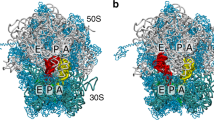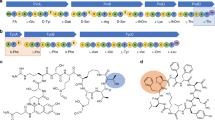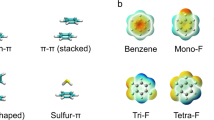Abstract
Yeast tRNAPhe is an L-shaped molecule, where each arm is a short segment of double-helical RNA. Examination of the crystal structure has suggested that the molecule may be hinged, perhaps in the region where the anticodon stem meets the D stem1, or where the two arms of the molecule meet2. Because tRNA interacts with a variety of macromolecules during protein synthesis, and because it performs various functions in addition to its role in protein synthesis3, the idea of a hinge is attractive: such conformational flexibility would facilitate functional flexibility. Here we present the results of a theoretical study of the bending of tRNAPhe about the proposed hinge at the junction of the two arms2, applying the conformational energy calculation method used previously to examine flexibility in lysozyme4 and in DNA5. The model is surprisingly flexible, swivelling with two degrees of freedom through angles as large as 30° at an energetic cost of only a few kcal per mol. These energies are comparable with that of a few hydrogen bonds, suggesting that solvent conditions and interactions with other molecules are important in modulating structure and flexibility.
This is a preview of subscription content, access via your institution
Access options
Subscribe to this journal
Receive 51 print issues and online access
$199.00 per year
only $3.90 per issue
Buy this article
- Purchase on Springer Link
- Instant access to full article PDF
Prices may be subject to local taxes which are calculated during checkout
Similar content being viewed by others
References
Robertus, J. D. et al. Nature 250, 546–551 (1974).
Olson, T., Fournier, M. J., Langley, K. H. & Ford, N. C. J. molec. Biol. 102, 193–203 (1976).
LaRossa, R. & Soll, D. in Transfer RNA (ed. Altman, S.) 136–167 (MIT Press, Cambridge, Massachusetts, 1978).
McCammon, J. A., Gelin, B. R., Karplus, M. & Wolynes, P. G. Nature 262, 325–326 (1976).
Levitt, M. Proc. natn. Acad. Sci. U.S.A. 75, 640–644 (1978).
McCammon, J. A., Wolynes, P. G. & Karplus, M. Biochemistry 18, 927–942 (1979).
Jack, A., Ladner, J. E. & Klug, A. J. molec. Biol. 108, 619–649 (1976).
Jack, A. et al. J. molec. Biol. 124, 523–534 (1978).
Bernstein, F. C. et al. J. molec. Biol. 112, 535–542 (1977).
Levitt, M. J. molec. Biol. 82, 393–420 (1974).
Miller, K. J. Biopolymers 18, 959–980 (1979).
Northup, S. H. et al. Nature 286, 304–305 (1980).
Kim, S.-H. Prog. Nucleic Acid Res. molec. Biol. 17, 181–216 (1976).
Schimmel, P. R. & Redfield, A. G. A. Rev. Biophys. Bioengng 9, 181–221 (1980).
Breslauer, K. J. & Sturtevant, J. M. Biophys. Chem. 7, 205–209 (1977).
Ornstein, R. L. et al. Biopolymers 17, 2341–2360 (1978).
Konnert, J. H. & Hendrickson, W. A. Acta crystallogr. A36, 344–350 (1980).
Author information
Authors and Affiliations
Rights and permissions
About this article
Cite this article
Harvey, S., McCammon, J. Intramolecular flexibility in phenylalanine transfer RNA. Nature 294, 286–287 (1981). https://doi.org/10.1038/294286a0
Received:
Accepted:
Issue Date:
DOI: https://doi.org/10.1038/294286a0
This article is cited by
-
Prediction of solution properties and dynamics of RNAs by means of Brownian dynamics simulation of coarse-grained models: Ribosomal 5S RNA and phenylalanine transfer RNA
BMC Biophysics (2015)
-
The use of bonding between tRNAs to implement early peptide synthesis
Journal of Molecular Evolution (1991)
Comments
By submitting a comment you agree to abide by our Terms and Community Guidelines. If you find something abusive or that does not comply with our terms or guidelines please flag it as inappropriate.



